
Léon (1885 -1918) et Robert Morane (1886-1968)
et Raymond Saulnier (1881 - 1964)
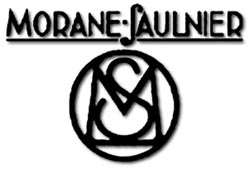 Morane-Saulnier history
Morane-Saulnier history
hep2.physics.arizona.edu
Léon and Robert Morane and their long time close friend Raymond Saulnier formed the Sociètè Anonyme des Aèroplanes Morane-Saulnier on October 10, 1911 at Puteaux (Paris region).
The vast output over the years ensued of 140 different types, the early designs being primarily braced monoplanes, leading to 2-seat Type G (1912), single-seat Type H and Type L (1913) and shoulder-wing Type N (1914).
Various parasol monoplanes (notably Type AI in 1917, 1,210 built) and biplanes followed. The Type AR parasol-wing trainer (1915) continued postwar as M.S.35 (400+ built), the Type P reconnaissance aircraft (565 produced) being similar.
From 1920 Morane-Saulnier concentrated on radial-engined parasol-wing fighters and trainers, several of them reaching 3-figure total and M.S.230 trainer (1929) exceeding even 1,100 examples and M.S.315 trainer (1932) being built in 346.
The M.S.405 fighter (August 8, 1935) was a low-wing monoplane with retractable landing gear, but had an outdated structure and an engine of only 860hp, so the production version M.S.406 (1,081 delivered until the Armistice of June 1940, making it the numerically most important French fighter of its time) was no match for the German Bf 109E.
The M.S.470 Vanneau advanced trainer of December 1944 was built in 500 examples and 3 different versions. This was followed by a number of single- and twin-engined light aircraft, ending with 165 machines of the M.S.760 Paris 4-seat twin-jet (1954) and the M.S.880 Rallye light 3-seater (1959).
The company was taken over in 1963 by Potez as Soc. d'Exploitation Etablissements Morane-Saulnier, this was followed by a reorganization in May 1965 as a subsidiary of Sud-Aviation and losing of the identity as part of SOCATA.
Gunston, W.(Bill), World Encyclopedia of Aircraft Manufacturers
Léon et Robert Morane et Raymond Saulnier
http://perso.wanadoo.fr/
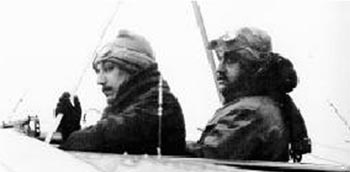
Robert and Léon Morane, c.1912
Léon Morane emportant son frère Robert comme passager se dispose à conquérir le prix Michelin Paris-Clermont-Ferrand (Puy-de-Dôme), sur monoplan Blériot, moteur Gnôme 100 chevaux. Le déplacement d'un bidon amena le coincement d'une commande motivant une chute terrible où les deux hardis aviateurs faillirent trouver la mort.
http://perso.wanadoo.fr/d.fauvel
download the full image
Léon o 11 avril 1885 à Paris, y décédé de la grippe espagnole en octobre 1918. Il fut le premier, en 1910, à battre le record de vitesse (100 km/h) et le record d'altitude (supérieur à 2.000m). Son frère, Robert, né en 1886, à Paris, y décédé le 28 août 1968. Pilotes, tous les deux, sont à l'origine de la Société Morane-Saulnier qu'il ont fondée avec l'ingénieur Raymond Saulnier, le 10 octobre 1911.
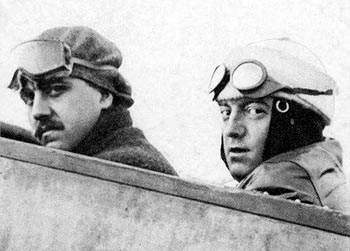
Léon Morane, and Raymond Saulnier, 1913
En 1905, Raymond Saulnier sort ingénieur de l' Ecole Centrale. Il fait ensuite son service militaire à Poitiers, puis un stage de quelques mois dans une banque. Il part en Amérique du Sud où plusieurs grands travaux sont en cours : agrandissement des ports de Para et de Manaos, construction de chemins de fer, modernisation de villes, etc...
Après quelques périties et dangers réels (raids d'Indiens Jivaros, par exemple), il rentre en France, à Paris. L'aviation est à ses débuts, et le jeune ingénieur est séduit par ces perspectives d'avenir. Ce sera sa vie.
Pendant plusieurs mois (mai 1908 - octobre 1909), il collabore avec Blériot (biplan Goupy à ailes décalées). Parallélement, il est rédacteur en chef d'un périodique d'Aviation, et écrit Etude, centrage et classification des Aéroplanes. C'est un succés et ce livre fera autorité en la matière.
Enfin grâce à l'aide de sa mère et de quelques amis, il peut monter sa propre affaire. La Société des Aéroplanes Raymond Saulnier installe son atelier à Courbevoie où seront produits plusieurs appareils et delà transportés pour les essais à Louvercy, près de Mourmelon-le-Grand dans la Marne.
C'est là que R. Saulnier a son terrain d'essais et un atelier de réparations. Dès 1910, il se met au pilotage pour essayer lui-même ses appareils. Il n'a cependant jamais tenté d'obtenir son brevet de pilote, trop occupé.Le capital de l'entreprise n'étant pas suffisant pour continuer la fabrication, il doit cesser son activité. Mais il s'était fait un nom, une réputation.
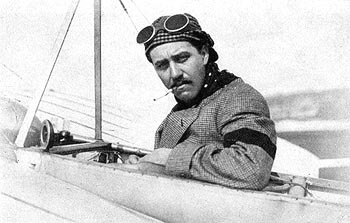
Léon Morane, c.1913
download a 1000pixel image
A la fin de 1910, il constitue une association avec Gabriel Borel, représentant des Avions Blériot, et Léon Morane, pilote renommé de ces mêmes Blériot. Leur premier appareil serait appelé Morane bien qu'il fut entièrement conçu par Saulnier.
C'est un Morane qui franchira le premier le cap des 100 km-h, piloté par Léon Morane. Nouveau tournant, l'entreprise se dissocie. Robert Morane s'associe avec Raymond Saulnier, ce sera la Société Morane-Saulnier (10 octobre 1911).
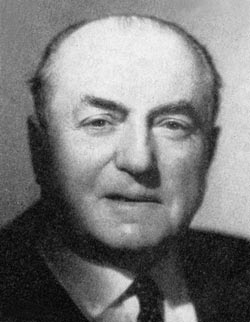
Raymond Saulnier in 1957
Léon Morane, né le 11 avril 1885 à Paris, meurt, victime de la grippe espagnole, en octobre 1918. C'est lui qui, le premier en 1910, battra le record de vitesse (100 km-h) et celui d'altitude supérieure à 2.500 m. Robert Morane, né en 1886, décédera à Paris, le 28 août 1968.
N.B. Tous ces renseignements sont tirés d'articles et d'entretiens parus dans la presse écrite. Par exemple, lorsque Raymond Saulnier sera nommé à la tête de l'Union Syndicale des Industries Aéronautiques, fin 1941, le mandat de Monsieur de l'Escaille ayant pris fin. In "Nouvelles d'Aviation", Paris 1942.
Morane-Saulnier Types
The following is drawn from more than a dozen sources. As such, in a number of cases, a best guess has been made over conflicting information. [Ed. 03, 2002]
Morane-Saulnier Type A, 1910
Training monoplane. 13 built for the French army.
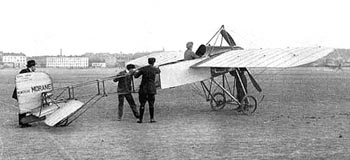
Morane-Saulnier Type A
download a 750pixel image
Morane-Saulnier Type B, 1911
Morane-Saulnier Type C, 1911
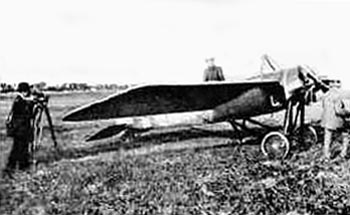
Morane-Saulnier Type C
Morane-Saulnier Type D, 1912
Morane-Saulnier Type E, 1913
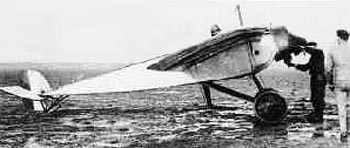
Morane-Saulnier Type E
Morane-Saulnier Type F, 1913
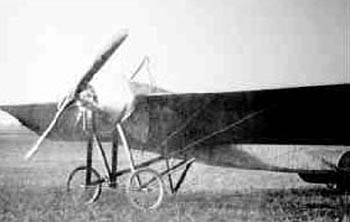
Morane-Saulnier Type F
Morane-Saulnier Type G, 1913
http://www.internetmodeler.com
The Morane-Saulnier Type G first appeared in Russia in 1913 and was used to establish some of the first Russian height and distance records. It was admitted to Russian military service that same year as a reconnaissance aircraft. Remaining in frontline service till its withdrawal at the end of 1915, the type continued to enjoy a role in flight training schools for some time into the 1920's.
It was using this type that two of the most famous (if not desperate) early attempts at engaging the enemy in the air, were carried out by Russian airmen. In September 1914, Captain Nesterov rammed a German reconnaissance aircraft in a suicide attack. Needless to say Nesterov and both of the German crew perished as a result.
More well known are the aerial exploits of Lieutenant Kozakov (Russia's first ace with 17 victories). He had the unorthodox idea of utilizing a small charge of explosive attached to a boat anchor to grapple the wings of an opposing machine. After some practice he used this method to bring down a German Albatros reconnaissance aircraft in March 1915.
For the most part these aircraft went unarmed although some had a Madsen machine gun mounted and angled to avoid the airscrew, its effectiveness was hampered by the slow rate of fire of the Madsen and the difficulty achieving a well aimed shot.
also...
Morane-Saulnier Type G : 'Roleur'
http://www.worldwar1.com
Pilot training philosophy in France differed from that in other countries. In France, it was presumed that student pilots learned better by doing rather than by watching. Therefore, the instructor rarely, if ever, went aloft with the student. From the very beginning the student would be told, on the ground, what the instructor wanted him to do. He would then get into the airplane and learn by doing.
Initial instruction was given in a variety of aircraft that had been deliberately modified to prevent them from flying (usually by clipping several feet off of the wings). This enabled the plane to roll along the ground; hence the generic name of 'Roleur' for such aircraft. Other, unofficial, nicknames assigned to such craft were 'Grasshopper' and 'Penguin'.
The purpose of such aircraft was both to allow the student pilot to learn how to manipulate the manets controlling the gas and air mixture to the rotary engine and to teach the student aviator how to control the direction of movement of the aircraft over the ground by the use of the rudder.
Up to the entry of the United States in the war all American citizens travelling to France and enlisting in the Aviation Militaire underwent initial training on such aircraft; including those who became members of the Lafayette Escadrille.
While numerous combat obsolete aircraft were used in this mode one of the more frequently used was the Morane-Saulnier Type G. The Société Anonyme des Aéroplane Morane-Saulnier brought out the Type G in 1913. It was a single-engine monoplane with shoulder-mounted wings. It came in both a single-seat and a two-seat configuration.
Following its combat history the aircraft was relegated to training duties. For training only the single-seat version was used. The Aviation Militaire purchased ninety-four Type G's. When used in training the Morane-Saulnier Type G came in four configurations.
Army Type No. 16 with a 45 hp Anzani engine
Army Type No. 17 with a 3 cylinder Anzani with nose-guard
Army Type No. 18 with a 3 cylinder Anzani without nose-guard
Army Type No. 19 with a 80 hp LeRhône engine
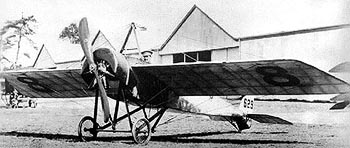
Morane-Saulnier Type G
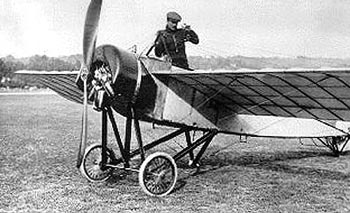
Morane-Saulnier Type G
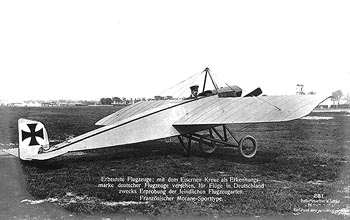
Morane-Saulnier Type G
download a 750pixel or 1000pixel image
Morane-Saulnier Type H, 1913
http://www.kwmairpl.com.ph
Famous by the achievements of the company pilot Roland Garros, the Morane-Saulnier Type H, designed in 1912, became very popular, especially after Garros' crossing the Alps and the Mediterrean Sea. In 1913 it was equipped with floats and participated in the first Schneider Trophy Race for seaplanes in Monaco.
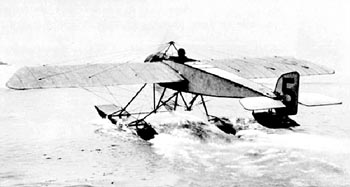
Morane-Saulnier, Schneider Trophy Race 1914
download a 750pixel image
The aircraft incorporated wingwarping for lateral control and had balanced all flying elevator and balanced rudder but without fin. An original aircraft (landversion) is on display at Musée de l'Air in Paris and a number of airworthy replicas exist in France and elsewhere.
also...
Morane-Saulnier Type H, 1913
http://www.xkalibor.com
Type: Reconnaissance
Year: 1913
Engine: Gnome rotary, 80 hp
Wingspan: 29' 11" (9.12 m)
Length: 20' 7" (6.28 m)
Height: 7' 6" (2.30 m)
Weight (Empty):
Weight (Gross): 1,034 lbs. (470 kg)
Speed: 85 mph (135 km/h)
Ceiling: 3,280 ft. (1,000 m)
Endurance: 3 hrs.
Range: Armament: 1 machine gun
Crew: 1
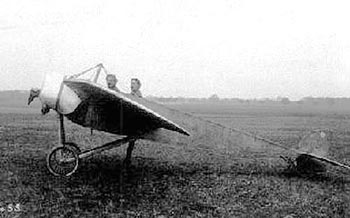
Morane-Saulnier Type H
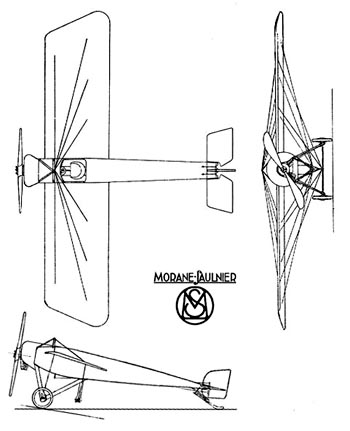
Morane-Saulnier Type H
http://www.lincolnbeachey.com
Morane-Saulnier Type L, 1913
http://www.wwiaviation.com
A "parasol" monoplane, the Morane Type L was a fragile two-seat reconnaissance aircraft. It was the first aircraft armed with a fixed machine gun that fired through the propellor arc.
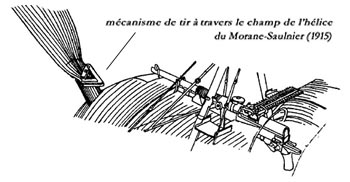
Garros deflector system
Bullets which struck the propellor were deflected by steel plates. Armed with a Hotchkiss machine gun firing 8 mm solid copper bullets, Roland Garros tested the design in April 1915. He scored three victories in three weeks before the plane was captured by the Germans.
Type : Fighter Reconnaissance
First Introduced : 1913
Number Built : 600
Engine : Gnome, rotary, 80 hp
Wing Span : 36 ft 9 in 11.2 m
Length : 22 ft 63/4 in 6.88 m
Height : 12 ft 101/2 in 3.93 m
Empty Weight : 385 kg
Gross Weight : 1,441 lb 655 kg
Max Speed : 71.5 mph 115 kmh
Ceiling : 13,123 ft 4000 m
Endurance : 21/2 hours
Crew : 1 or 2
Armament : 1 machine gun
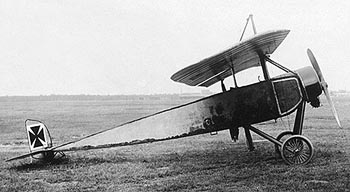
Morane-Saulnier Type L
http://www.cals.lib.ar.us
Morane-Saulnier Type P, 1914
The Type P was a development of the Type L parasol-wing monoplane. 565 built. There were also two single-seat fighter versions, one with the standard parasol wing and one with the wing lowered to the top of the fuselage.
Type P
Function: reconaissance
Year: 1914
Crew: 2
Engines: 1 * 110hp Le Rhone
Wing Span: 11.20m
Length:
Height:
Wing Area:
Empty Weight:
Max.Weight: 732kg
Speed: 156km/h
Ceiling: 4876m
Range: 2h 30m
Armament: 1-2*mg7.7mm
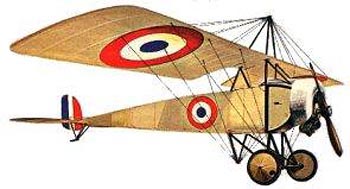
Morane-Saulnier Type P
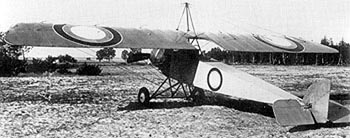
Morane-Saulnier Type P
Morane-Saulnier Type LA, 1913
Improved Type L with ailerons instead of wing warping.
Morane-Saulnier Type AR, 1915
Parasol-wing trainer, developed from the Type LA. Over 400 were built.
Type AR
Function: trainer
Year: 1915
Crew: 2
Engines: 1 * 60kW Le Rhone 9C
Wing Span: 10.57m
Length:
Height:
Wing Area:
Empty Weight:
Max.Weight: 764kg
Speed: 125km/h
Ceiling: 4600m
Range:
Morane-Saulnier Type N, 1914-15
http://wwwusers.imaginet.fr
Developed from the Type G and Type H pre-war racing monoplanes, the Type N entering French service in small number in mid 1915. Early Type Ns were equipped with a crude metal deflector, attached to the propellor blades to protect it from the attentions of the fixed Hotchkiss machine gun, mounted on top of the fron fuselage.
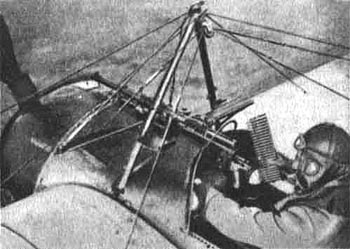
Morane-Saulnier Type, showing Hotchkiss mg and Garros deflector system
Pilot Jules Védrines
http://www.fiddlersgreen.net
This had previously been tried on the Type L flown by ace (and pre-war tennis star) Roland Garros, who was captured in this machine 19 April 1915. Although it looked an effective fighter (and was better than the German Fokker E3), it was slow and difficult to fly.
Although attempts were made to fit more a powerful engine, the extra weight made the Type N even more difficult to fly, resulting in its (and related Type I and Type V) replacement in British service in the autumn of 1916. Some Type Ns also saw service with the Russians.
also...
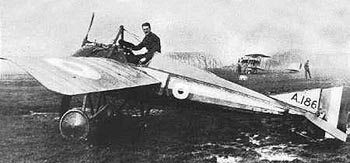
Morane-Saulnier Type N. Serial No. 186
This aircraft (A186) was flown by Lt. T.P.H. Bayetto of 60 Sqn. R.F.C., July, 1916
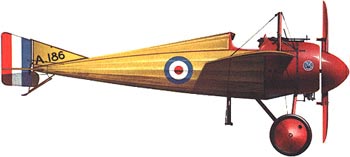
Morane-Saulnier Type N. Serial No. 186
This aircraft (A186) was flown by Lt. T.P.H. Bayetto of 60 Sqn. R.F.C., July, 1916
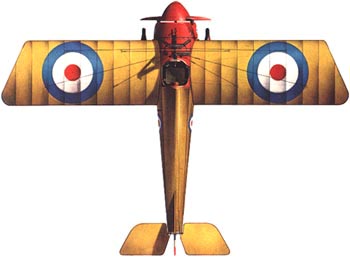
Morane-Saulnier Type N. Serial No. 186
This aircraft (A186) was flown by Lt. T.P.H. Bayetto of 60 Sqn. R.F.C., July, 1916
also...
Morane-Saulnier Type N, 1914-15
http://www.accessweb.com
The Type N 'Bullet' was a mid-wing monoplane, which became the first French fighter aircraft. Due to the shortage of decent fighting scouts from England, the British also used the 'Bullet'. The Type N was fitted with a fixed Hotchkiss machinegun, but without a synchronization gear, as the Allies had not developed it yet. Instead the Bullet used metal bullet deflectors on the propellor blades instead, as pioneered by Roland Garros on a Type L.
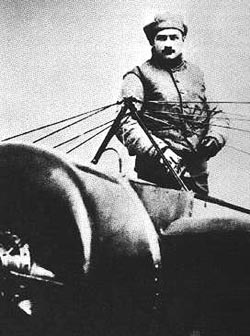
Roland Garros
However, this development was not very successful, as the impacts of the bullets on the deflectors could still shatter the propellor or weaken the motor mount, with disastrous results. Also, there were occasional rebounds of the bullets back at the pilot. While there was no indication that any pilot was killed from this, it was none-the-less a frightening situation.
The Type N was less popular than the Type L 'Parasol' monoplane. The Type N did not fair very well against the Fokker Eindecker. Only some 49 were built in 1917. Aircraft development proceeded so fast that most planes were nearly obsolete when they reached the fighting squadrons at the front.
The Type N was powered by the 110hp Le Rhone 9J rotary, air-cooled engine. This gave it a speed of 165km/h, a ceiling of 4000m and an endurance of 1h 30m. It was armed with a single forward firing Hotchkiss machine gun using bullet deflectors on the propellor blades.
also...
Morane-Saulnier Type N, 1914-15
http://www.spartacus.schoolnet.co.uk
Raymond Saulnier and the brothers, Robert Morane and Leon Morane, began producing aircraft in France in 1913. On the outbreak of the First World War the company joined with Roland Garros, to develop a system that would enable the pilot to fire the gun only when the propeller was out of line with the target.
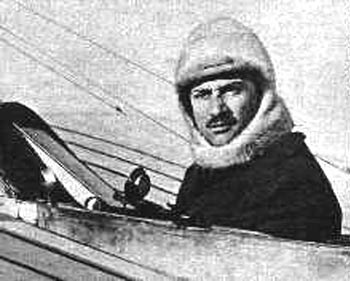
Roland Garros
Early versions did not work properly and the pilots found they were destroying their propellers rather than enemy aircraft with their machine-gun fire. In the early months of 1915, Roland Garros, added deflector plates to the blades of the propeller of his Morane-Saulnier Type L. These small wedges of toughened steel diverted the passage of those bullets which struck the blades.
Over the next two weeks Garros shot down five enemy aircraft with his adapted Morane-Saulnier Type L. However, the success was short-lived because on 18th April, a German rifleman managed to fracture the petrol pipe of the aircraft that Garros was flying. Garros was forced to land behind the German front-line and both he his machine were captured by the Germans.
In 1914 the company also produced the Morane-Saulnier Type N. A plane of very advanced design, it was extremely fast but also difficult to handle. Its high landing speed resulted in a large number of crashes. Although rated high as a fighter plane, it was only given to highly experienced pilots to use over the Western Front.
also...
Morane-Saulnier Type N, 1914-15
http://www.wwi-models.org
In 1911, Raymond Saulnier and his childhood friends Leon and Robert Morane formed the Morane-Saulnier Airplane company to manufacture monoplanes. In December, 1913, they exhibited two shoulder-wing monoplanes, Type G and Type H, and an early Type L parasol-wing monoplane, at the Paris Salon.
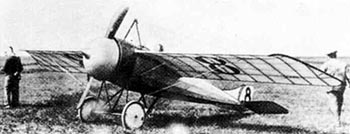
Morane Saulnier Type N, Prototype
Within six months, they produced the first Type N, a significant development of the Type G and Type H: it retained the shoulder-wing design, but faired out the fuselage into a circular cross section, and a large spinner nearly covered the 80 hp Gnome engine (this was later to cause cooling problems.)
Despite its relatively sleek and streamlined appearance, the airplane's early date was betrayed by its flimsy tail surfaces and its use of wing-warping instead of ailerons for flight control. When war came, the Morane-Saulnier aircraft were among the first to fly over the trenches; a primitive method of firing a machine gun through the arc of the propellor, using bullet-deflecting steel wedges on the back of the propellor, was installed on Type L aircraft and later on the Type N.
A revised Type N made its appearance in the summer of 1915, with the 80 hp Le Rhone engine now standard; it was immediately popular with French pilots but the 25 or so built were scattered among various escadrilles. The British bought another 25 'Bullets' and had moderate success against German observation planes until the introduction of the Fokker E series airplanes. [Karen Rychlewski]
also...
Morane-Saulnier Type N, 1914-15
http://www.fiddlersgreen.net
By 1913 monoplane design had reached a very high level in France, and the Deperdussin and Morane single seaters of that year were remarkably well streamlined.
The Type N or Monocoque-Morane was a mid-wing monoplane powered by the 80 h.p. Gnome or 110 h.p. I. Rhone engine. The airscrew had a large spinner, named 'la casserole', which left only a small annular opening for cooling the engine, so that it was often discarded in hot weather. The typical Morane wings were of wood and fabric construction with flexible tips to allow for warping.
The fuselage was not a true monocoque; its circular section was formed by fitting light stringers over a wooden frame A balanced elevator was fitted the triangular fin and plain rudder were of low aspect-ratio. Like most of the Morane types, the undercarriage struts were of 'M' shape when viewed in front elevation.
Early in 1914 Raymond Saulnier devised a true synchronising gear, using a Hotchkiss gun borrowed from the French Army. Difficulties were caused by the faultiness of the standard ammunition supplied, and Saulnier replaced his gear with a crude arrangement of steel deflectors fixed to the airscrew blades; those bullets which did not pass between the blades were deflected by the steel plates. On the outbreak of war, the idea was temporarily abandoned.
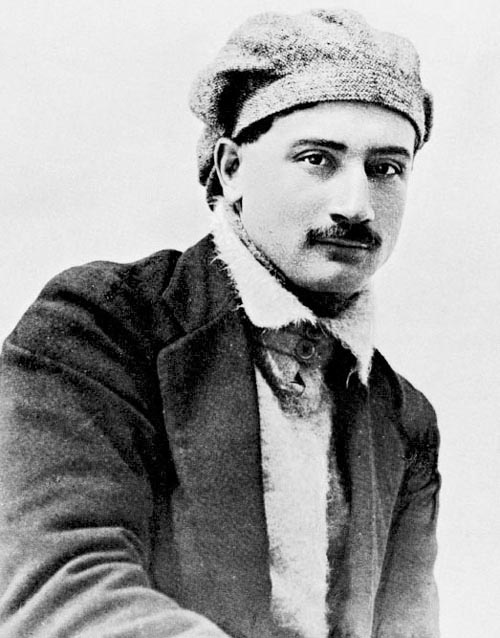
Roland Garros
Among the well-known pre-war pilots serving with Escadrille MS. 23 early in the war was Roland Garros. The unit commander, Capitaine de Vergnette, on his own initiative sant Garros to Villacoublay to co-operate with Saulnier. In March 1915 Garros returned with a Morane Type N armed with a fixed Hotchkiss gun capable of firing through the airscrew arc.
Deflector plates were fitted to the airscrew blades. A German two-seater was shot down in flames on April 1st, 1915, and other victories followed on the 13th and 18th of the same month. The next day he forced-landed on the wrong side of the lines, and the device fell into German hands. As a direct result of this capture, the Fokker synchronising gear was developed.
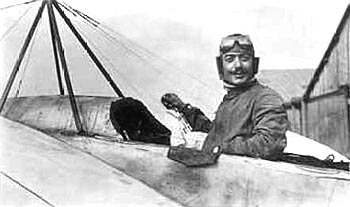
Adolphe Pegoud
http://www.fiddlersgreen.net
Other French pilots quickly obtained Morane single seaters; the Type N was flown by Navarre, the first French ace and by Adolphe Pegoud, the pre-war exhibition pilot who shot down six enemy aeroplanes before being killed on August 31st, 1915. Later machines were armed with a synchronised Vickers gun.
The British purchased a few Type Ns, which were used b Nos. 3 and 60 Squadrons, R.F.C., during the summer of 1916. The type became known as the 'Bullet' in the R.F.C.; it was armed with a Lewis gun. Ns were also supplied to the Russian 19th Squadron.
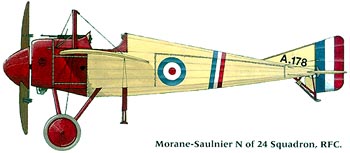
Morane-Saulnier Type N
http://www.pilots-n-planes-ww1.com
download a 750pixel image
A captured Fokker monoplane (probably an E-III) and a 'Bullet' were flight-tested together in April 1916, and the Morane was found to have the better performance. It was not an aeroplane for a beginner, however, having very high landing speed and extreme fore-and-aft sensitivity.
Some Monocoque-Moranes had strengthened under carriages, modified cowlings and smaller spinners. The Type N and Type AC were 1916 developments; some thirty of the latter type were constructed, but it is doubtful if it formed the equipment of any operational unit. The wings were strut braced from below.
also...
Morane-Saulnier Type N, 1914-15
http://www.fiddlersgreen.net
If there was one single overriding consideration in aircraft construction during the First World War, it was the quest for aeroplanes that could fly higher, faster, farther, and could lift greater payloads. There were basically three ways in which this could be done: By streamlining and making it aerodynamically cleaner, by lightening it, and by increasing engine power.
For the most part the third of these options was the one most commonly used except as in the case of the 'Bullet'. Incredibly, its empty weight was only 635 lb and its loaded weight was 981 lbs.* The Type N with its circular section fuselage and huge domed spinner was more aerodynamic-ally advanced than any airplane that flew in the entire war!
Despite all these advancements, it was not that popular with the pilots. The bottom line was that it basically was a light weight, armed improvisation based on a pre-war racing aircraft with a high landing speed and delicate handling characteristics. According to one RFC Moraine pilot, 'Our main preoccupation once having got into the air was to get down again'.
The 49 Type Ns that were built were used by the French Air Force, RAF and the Russian Air Service. The real reason for this aeroplane's place in aviation history (and how it changed fighter design for all time) is the fact that Raymond Saulnier had invented a rudimentary synchronizing gear for machine guns enabling the gun to shoot between revolving blades of the propeller.
There was one catch, however, the service ammunition was not of high quality, and occasionally delayed in firing just long enough to hit one of the blades. So he also installed steel deflectors with the idea that they would take care of any bullet that didn't pass between the blades.
The soon to be famous French fighter pilot Roland Garros achieved several victories in quick succession before being forced down behind the lines with engine trouble. Anthony Fokker copied and improved the concept and within days the Germans were installing synchronizing gear on the Fokker EIII Eindeckers.
*For comparison, the SPAD XIII, the fighter with which the Allies finished up the war, weighted 1,255 lb empty and 1,808 lb loaded.
The Morane-Saulnier Bullet was a very early single winged scout (1914) that evolved from a racing aeroplane of the day. Great for racing but disastrous as a Scout because pilots were so pre-occupied with worry about getting back down. The Bullet was the first aeroplane to have a gun that could, more or less, fire through the propeller.
Type N
Function: reconaissance / fighter
Year: 1917
Crew: 1
Engines: 1 * 110hp Le Rhone 9J
Wing Span: 8.15m
Length: 5.83m
Height: 2.25m
Wing Area: 11.00m2
Empty Weight:
Max.Weight: 443kg
Speed: 165km/h
Ceiling: 4000m
Range: 1h 30m
Armament: 1*mg
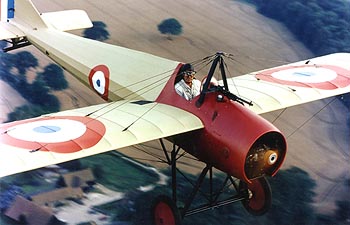
Morane-Saulnier Type N
http://www.retromobile.fr
download a 1000pixel image
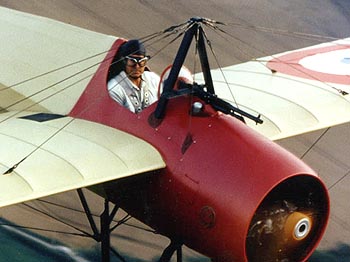
Morane-Saulnier Type N
http://www.retromobile.fr
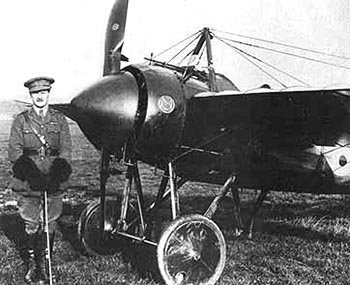
Morane-Saulnier Type N
http://www.1freespace.com/ aerodrome/rb3.html
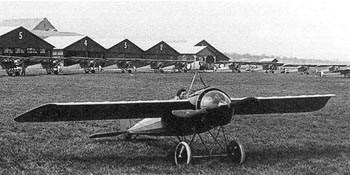
Morane-Saulnier Type N
http://www.pilots-n-planes-ww1.com
download a 750pixel image
download full 1000pixel or 1500pixel image
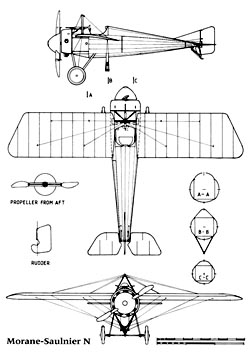
Morane-Saulnier Type N
http://www.pilots-n-planes-ww1.com
download a 750pixel image
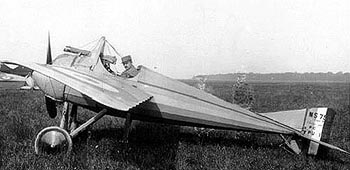
Morane-Saulnier Type N
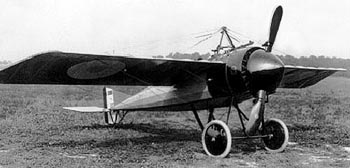
Morane-Saulnier Type N
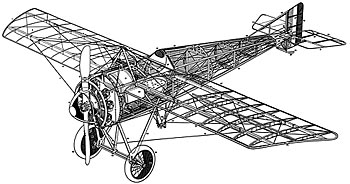
Morane-Saulnier Type N
download a 1000pixel or 2000pixel image
Key to the Morane-Saulnier Type N 2000 pixel image
Created for RAM January 22, 2000 by Thomas Heinz
- Starboard wing-tip
- Fabric-covered wing panel
- Wing internal diagonal wire bracing
- Upper warp control cables
- Upper front spar bracing cable
- Starboard leading edge
- Lower bracing cable
- Aluminum spinner
- Propeller hub fixing bolts
- Two-bladed fixed-pitch wooden propeller
- Machine gun bullet deflector plate
- Aluminum engine cowling ring
- 80hp Le RhÙne nine-cylinder rotary engine
- Steel engine mounting bulkhead
- Cowling stiffener
- Front gun mounting
- Cowling fasteners
- Rudder pedal bar
- Bottom of control column
- Oil tank
- Fuel tank, capacity 50l
- Gun mounting struts
- Fuel filler cap
- Strip magazine (30 rounds)
- Upper cabane struts
- Bracing wire fixtures
- Warp control wire pulley
- Windscreen
- Hotchkiss 8mm machine gun
- Ammunition magazine guide
- Spare magazines
- Cockpit coaming
- Engine instruments
- Pilot's seat
- Fuselage diagonal frames
- Rear spar centre section bracing
- Cockpit shoulder fairing
- Headrest
- Tapered fuselage head fairing
- Fuselage upper longerones
- Horizontal spacers
- Light plywood formers
- Tail fin front fixing
- Starboard tailplane/elevator
- Fin leading edge
- Rudder control horn
- Rudder construction
- Wire trailing edge
- Tailplane construction
- Tailplane wire trailing edge
- Port tailplane/elevator
- Hinged tailplane spar
- Elevator horn control
- Tailplane control cables
- Fuselage fabric covering
- Rudder ventral horn balance
- Skid mounting strut
- Tailskid
- Skid steel shoe
- Elastic cord shock absorber
- Fuselage stringers
- Stringer fixing former
- Fuselage bottom longeron
- Vertical spacers
- Tail control cable runs
- Fuselage diagonal wire bracing
- Wing fixed trailing edge
- Flexible rear spar
- Upper warp control cables
- Wing internal wire bracing
- Wing stringers
- Raked wing-tip construction
- Rigid front spar
- Wing rib construction
- Front spar bracing wires
- Port leading edge
- Lower warp control cables
- Ventral control cable pylon
- Warp cable hinge control
- Main undercarriage rear strut
- Port main wheel
- Tire valve access hole
- Wheel spokes
- Undercarriage front strut
- Sprung axle beam
- Undercarriage centre pylon mounting
- Starboard undercarriage struts
- Elastic cord shock absorber
- Aluminum wheel disc
- Starboard mainwheel
Morane-Saulnier Type I, 1916
http://204.50.25.179
The Morane-Saulnier Type I was developed from the Type N. Its general profile differed little with exception of the scalloped trailing edges on the wings and horizontal tailplanes. It was powered by a more powerful 110 hp LeRhone 9J rotary as opposed to the 80 hp LeRhone 9C incorporated in the Type N.
The Type I also utilized the British Vickers Mk I machine gun synchronized by the French Alkan-Hamy gear, which was a copy of the early Fokker system. Most Type I 'Bullet''s were flown by French escadrilles MS12, MS23, MS49, AND MS159. The British tested only four examples of the Type I and preferred to weather on with the Type N until Nieuport 17s were available.
The most combat seen by the Type I was in the hands of the 2nd, 7th, and 19th Fighter Detachments of the Imperial Russian Air Service. The Russian fighter pilot Ivan Smirnoff of the 19th Fighter Detachment was probably the only one who attained five or more victories flying either the Type N, Type I, or Type V Morane 'Bullet' monoplanes.
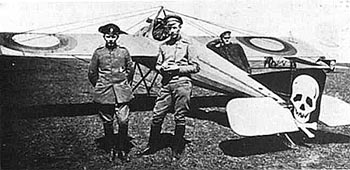
Morane-Saulnier Type I, Imperial Russian Air Service
Colour Profiles of World War Combat Planes by Giorgio Apostolo and Giorgio Begnozzi credit's Smirnoff with twelve kills using the Type I, but this may be conjecture as they also record the Frenchman Adolphe Pegoud with six victories using the Type N, whereas Norman Franks and Frank Bailey in Over the Front list all but one of Pegoud's victories whilst flying Maurice Farman two-seaters.
In Over the Front Franks and Bailey also show Eugene Gilbert with five victories whilst flying Morane-Saulniers, but three of these are credited as shared victories with his observers, thereby leading me to postulate that he was flying a two-seat Morane-Saulnier Type L or Type G at the time. I could find no other French ace with more than three victories in any Morane-Saulnier escadrille in Over the Front, nor could I find any reference of British aces flying the Type N.
Type I
Function: fighter
Year: 1916
Crew: 1
Engines: 1 * 110hp Le Rhone
Wing Span: 8.24m
Length: 5.81m
Height: 2.50m
Wing Area: 11.00m2
Empty Weight: 334kg
Max.Weight: 510kg
Speed: 168km/h
Ceiling: 3500m
Range: 1h 20m
Armament: 1*mg 7.7mm
Morane-Saulnier Types N, I and V
http://hep2.physics.arizona.edu
The first prototype of the Type N had its public debut at the flying meeting held at Aspern, Vienna from June 21-28, 1914, were it was flown with moderate success by the famous French pilot Roland Garros. This type was an attempt to achieve the same performance like the contemporary Deperdussin monocoques (at that time the most advanced aircraft in the world), but with a much simpler construction.
The design bore a family resemblance to the earlier Type G and Type H. The prototype was powered by an 80hp Gnome rotary engine and showed a rather peculiar distinctive feature in form of an enormous spinner. Like many other aircraft of its time this type had no ailerons, lateral control was by wing warping.
In April 1915 a single Type N appeared at the front (flown by Eugène Gilbert), this was either the same or a second prototype. Its armament consisted of a fixed forward-firing 8mm Hotchkiss gun, which fired unsynchronized through the propeller arc. To prevent damage, the air-screw was instead protected by two triangular steel deflector plates - a device pioneered by Roland Garros.
Soon afterwards a small production series was ordered for the French Aviation Militaire under the designation Type N. In official papers this type was designated as MoS.6.C1, but all Morane-Saulnier types of this series were popularly known as "Monocoques", albeit they were not of monocoque construction.
Maybe the largest user of this type was the British Royal Flying Corps, which received 27 machines of this type in 1916. Here the machines were known as Morane 'Bullets', their armament consisted of a single unsynchronized 7.7mm Lewis gun. Their flying characteristics left much to be desired, they were said to be too difficult to fly for the average pilot.
The Russians also received a number of Type N's in 1916 (another source quotes only one example) and one machine is known to have been under construction at the Dux works in Moscow in the same year, but was not completed. Total production of the Type N is believed to have been 49 machines.
In 1916 there appeared a version with an 110hp Le Rhône engine under the designation Type I. It seems that this type was used operationally by the French only in one or two examples, but the British received at least four examples and the Russians also received them in some numbers.
On April 1, 1917 there are reported eighteen machines of this type being in service with the only Russian user, the 19th Fighter Detachment - commanded by A.Kazakov - at Lutsk). They were the last operational aircraft of this type and some of them even survived the October Revolution.
Most common armament was one synchronized Lewis or Vickers gun with Alkan or Vickers-Challenger synchronizing gear. The last variant of the basic design was the Type V. This model also appeared in 1916 and had a much larger fuel capacity, which caused major redesign.
It is doubtful whether any of those aircraft were used by the French or Russian troops, but the British ordered twelve machines. At first it was planned to equip them with a Cadroy-Cordonnier mechanical bullet deflector instead of a synchronizing gear, but in fact most aircraft were delivered with a synchronized Vickers gun.
Type : Type N, Type I, Type V
Function : Fighter
Year : 1914, 1916, 1916
Crew : 1
Powerplant : 1
Type : Le Rhône 9C, Le Rhône 9J
Power : 80hp, 110hp
Size (m)
Length : 5.83, 5.815
Height : 2.25, 2.5, ?
Wingspan : 8.146, 8.242, 8.75
Wing area : 11m2 ?
Weights (kg) and loads
Empty : 188, 334 ?
Loaded : 444, 510 ?
Wing Load (kg/m2) : 40.4, 46.4 ?
Power load (kg/hp) : 5.55, 4.64 ?
Speed (km/h)
at 0m : 144 to 152, 176, 165
at 2000m : ?, 164, ?
Range
Flight Endurance : 1h30min, 1h45min, ?
Ceiling : ?m
Climb (min)
1000m : 4.0, 2.8, 3.3
2000m : 10 to 12, 6.3, 8.0
3000m : ?, 12.7, 15.3
4000m : 45, ?
Armament
Guns : 1*mg 8mm Hotchkiss, Lewis 7.7mm or 7.7mm Vickers
Morane-Saulnier Type BB, 1915
A small two-seat biplane. The Type BB had a very closely cowled rotary engine. Few were built, for British use only.
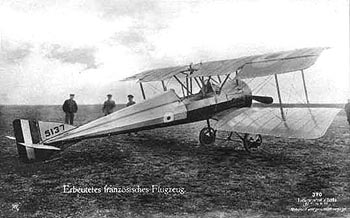
Morane-Saulnier Type BB, No.5137
Type BB
Function: reconaissance
Year: 1915
Crew: 2
Engines: 1 * 80hp Le Rhone
Wing Span: 8.65m
Length:
Height:
Wing Area:
Empty Weight:
Max.Weight: 750kg
Speed: 146km/h
Ceiling: Range:
Morane-Saulnier Type TRK, 1915
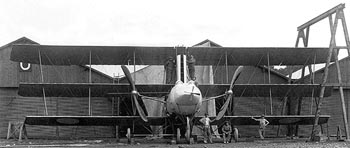
Morane-Saulnier Type TRK
http://www.pilots-n-planes-ww1.com
download a 1000pixel image
Morane-Saulnier Type BH, 1916
Development of the Type BB with in-line Hispano-Suiza engine. No production.
Morane-Saulnier Type T, 1916
Twin-engined reconaissance aircraft. About 100 built.
Type T
Function: reconaissance
Year: 1916
Crew: 3
Engines: 2 * 80hp Le Rhone
Speed: 137km/h
Ceiling: Range:
Armament:
Morane-Saulnier Type V, 1916
The Type V was a larger development of the Morane-Saulnier Type N. It was developed in parallel with the Type I. The Type V, like the Type I, had been ordered by the RFC and Russia, but the aircraft was very unpopular and few were built.
Type V
Function: fighter
Year: 1916
Crew: 1
Engines: 1 * 110hp Le Rhone 9J
Wing Span: 8.75m
Length: 5.81m
Height: Wing Area:
Empty Weight:
Max.Weight:
Speed: 165km/h
Ceiling: Range:
Armament:
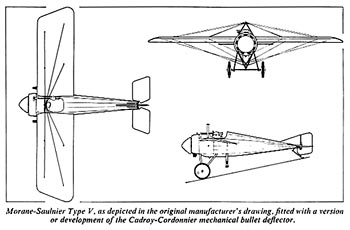
Morane-Saulnier Type V
Morane-Saulnier Type AC, 1916
Shoulder-wing fighter monoplane. The Type AC had ailerons, while the earlier Type N, Type G, Type I and Type V used wing warping. The Type AC was a clean, advanced design, but the SPAD S.VII was preferred, and only about 30 were built.
Type AC
Function: fighter
Year: 1916
Crew: 1
Engines: 1 * 120hp Le Rhone 9JB
Wing Span: 9.80m
Length: 7.05m
Height: 2.73m
Wing Area: 15.00m2
Empty Weight: 435kg
Max.Weight: 658kg
Speed: 178km/h
Ceiling: Range: 2h 30m
Armament: 1*mg 7.7mm
Morane-Saulnier Type AF, 1917
Fighter biplane, the first of this manufacturer that had previously built monoplane fighters. The Type AF had excellent handling and performance, but did not enter production because the it improved too little on the SPAD S.XIII.
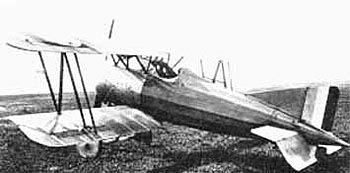
Morane-Saulnier Type AF
Type AF
Function: fighter
Year: 1917
Crew: 1
Engines: 1 * 150hp Gnome Monosoupape 9Nb
Wing Span: 7.47m
Length: 5.15m
Height: 2.35m
Wing Area: 15.31m2
Empty Weight: 421kg
Max.Weight: 649kg
Speed: 207km/h
Ceiling: Range:
Armament: 1*mg 7.7mm
Morane-Saulnier Type AFH, 1917
Shipboard, seaplane derivative of the Type AF.
Morane-Saulnier Type AI, 1917
Single-seat, parasol-wing monoplane fighter. The Type AI was built as the MoS.27C version with a single gun, the MoS.29C with two guns, and the MoS.30E.1 as trainer. The Type AI was considered to be the equal of the SPAD S.XIII, but the wing showed some weakness, and the combat career was very brief because of the unreliable engines. 1210 were built.
also...
Morane-Saulnier Type AI, 1917
http://www.wwi-models.org
The Morane-Saulnier company specialized in monoplanes, producing a series of models with good flying characteristics. The fear of monoplanes, however, limited their role in the air war and the Type AI was the last to suffer this prejudice. Developed from the Type P, the Type AI was a single-seat fighter which first flew in August, 1917, and was offered to British forces but Major-General Trenchard adamantly refused to consider it.
Well over 1000 of the Type AI were produced in two versions: the single-gun MoS.27.C1, and the two-gun MoS.29.C1. Re-equipping of Nieuport escadrilles with the new Morane-Saulnier began in January, 1918, and the plane was used by French, Belgian, and American forces. However, several fatal accidents in February and March involving the failure of the wing caused the type to be withdrawn. By May, 1918, all the Type AIs were gone from front-line duties.
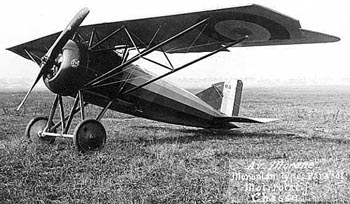
Morane-Saulnier Type AI
download a 1000pixel image
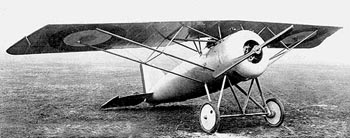
Morane-Saulnier Type AI
download a 1000pixel image
also...
Morane-Saulnier Type AI, 1917
http://memorial.flight.free.fr
By the autumn of 1915 the Morane-Saulnier Type N single-seater monoplane had been rendered obsolete by the appearance of the Nieuport 11 "Bébé". Subsequent developments of the Type N were all inferior to the Nieuport, so that the bulk of the Morane-Saulnier aircrafts built during 1916 were reconnaissance types. These included the twin engined Type T and two models which served with both French and British units, the single-bay Type BB biplane and the Type P parasol monoplane.
Two new single-seaters were brought out in 1917; the Type AF biplane and its parasol monoplane equivalent, the Type AI. The Type AF was powered by the 120 h.p. Le Rhône 9J rotary engine, and had staggered wings without dihedral and N-shaped interplane struts. The fuselage was round in section, tapering to a point at the tail, and the triangular fin and rudder were typically Morane. Little is known about the Type AF, which was evidently not a success.
The Type AI, on the other hand, went into production, the first examples being delivered late in 1917. It had either the 120 h.p. Le Rhône or the 160 h.p. Gnôme Monosoupape 9N rotary engine, mounted in a circular open-fronted cowling, the lower half of which was fretted with seven ventilation holes.
The parasol wing was swept back and carried horn-balanced ailerons; the wing-tips were raked and there was a large semicircular cut-out in the trailing-edge of the centre section. Spars and ribs were of wood, wire-braced and covered with fabric. An astonishing complexity of struts connected the wing to the fuselage.
Owing to the sweep back of the wing, the main struts sloped slightly backwards in side elevation. The fuselage, of circular section tapering to a point at the rear, was built up of wooden formers and stringers, covered with fabric except for the panelled portion between cowling and cockpit.
Braced from below by struts, the tail-plane was small in area, but carried fairly large elevators; the fin and balanced rudder were triangular in shape. As on most Morane-Saulniers, the undercarriage was additionally braced by a vee strut to the centre point of the spreader bar. Either one or two synchronised Vickers guns were fixed to fire forwards through the airscrew arc.
One unit, Escadrille 156, was equipped with Type AIs in January 1918. Some structural trouble was experienced initially, but many pilots liked the type's handling qualities. Other units are believed to have had one or two AIs on their strength for evaluation. In March 1918 the type was withdrawn from the front, and thereafter served as an advanced trainer.
Twelve hundred Type AIs were built, fifty-one of them being purchased by the American Expeditionary Force for use as pursuit trainers. The version with one gun was designated the M.S.27 C-1, that with two guns, the M.S.29 C-1, and the training model the M.S.30 E-1. After the war many continued in service: a number of these being re-equipped with 130 hp Clerget rotaries. One machine. piloted by Fronval and Joyce, was looped 11 consecutive times!
A great number of parasol monoplanes were produced by Morane-Saulnier between the wars, the best known perhaps being the M.S.130 and M.S.230.
Type AI
Function: fighter
Year: 1917
Crew: 1
Engines: 1 * 160hp Gnome Monosoupape 9N
Wing Span: 8.51m
Length: 5.65m
Height: 2.4m
Wing Area: 13.39m2
Empty Weight: 488kg
Max.Weight: 598kg
Speed: 208km/h
Ceiling: 7000m
Range: 2h 30m
Armament: 1-2*mg
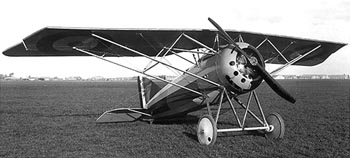
Morane-Saulnier Type 30E1
http://www.cals.lib.ar.us
download a 750pixel image
Morane-Saulnier Type AN, 1918
Two-seat biplane fighter, powered by a large 16-cylinder Bugatti liquid-cooled engine. Results were disappointing, and the Type AN was not ordered. Attempts to reengine the type produced the Type ANL, Type ANR and Type ANS, which also remained unsuccessful.
Type MoS.31 AN
Function: fighter
Year: 1918
Crew: 2
Engines: 1 * 450hp Bugatti
Wing Span: 11.73m
Length: 8.34m
Height: 2.77m
Wing Area: 41.00m2
Empty Weight:
Max.Weight: 1770kg
Speed: 225km/h
Ceiling:
Range:
Armament: 3*mg 7.7mm
Morane-Saulnier Type ANL, 1918
Development of the Type AN with a 400hp Liberty 12 engine. 1919. No production.
Morane-Saulnier Type ANR, 1918
Development of the Type AN with a 450hp Renault 12Kb engine. 1919. No production.
Morane-Saulnier Type ANS, 1918
Development of the Type AN with a 530hp Salmson 18Z engine. 1919. No production.
Unable to trace as of 03, 2002
Morane-Saulnier Type S
Morane-Saulnier Type U
Further Reading
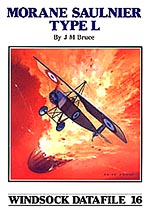 Bruce, J.M., Morane Saulnier Type L Windsock Datafile 16, Albatros Publications
Bruce, J.M., Morane Saulnier Type L Windsock Datafile 16, Albatros Publications
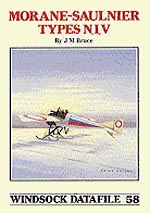 Bruce, J.M., Morane Saulnier Type N, I and V Windsock Datafile 58, Albatros Publications
Bruce, J.M., Morane Saulnier Type N, I and V Windsock Datafile 58, Albatros Publications
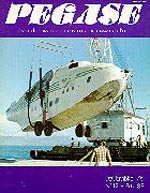 Lissarrague, Pierre, The Museum's Morane-Saulnier G, Pegase No. 12, Dec. 1978
Lissarrague, Pierre, The Museum's Morane-Saulnier G, Pegase No. 12, Dec. 1978
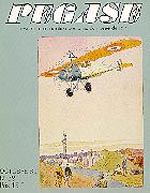 Lissarrague, Pierre, Léon Morane et la société des aéroplanes Morane-Saulnier, Pegase No. 39, Oct. 1985
Lissarrague, Pierre, Léon Morane et la société des aéroplanes Morane-Saulnier, Pegase No. 39, Oct. 1985
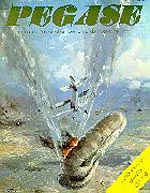 Reveilhac, Jean B., The Museum's Morane-Saulnier AI, Pegase No. 10, Jun. 1978
Reveilhac, Jean B., The Museum's Morane-Saulnier AI, Pegase No. 10, Jun. 1978
To be placed
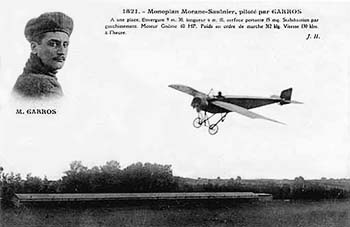
Morane-Saulnier Type, Pilot Roland Garros
A une place. Envergure 9m30, longueur 6m10, surface portante 15mq. Stabilisation par gauchissement. Moteur Gnôme 60HP. Poids en ordre de marche 312kg. Vitesse 130km/h.
http://perso.wanadoo.fr/d.fauvel
and some 60 years later...
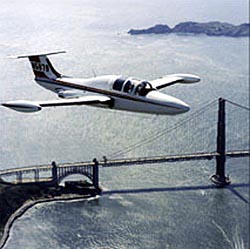
Morane-Saulnier 'Paris Jet'
Top | Pioneers Home
| 
